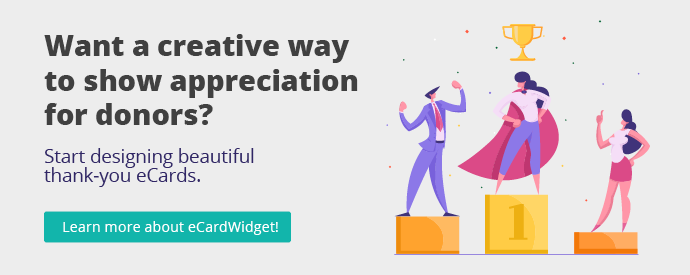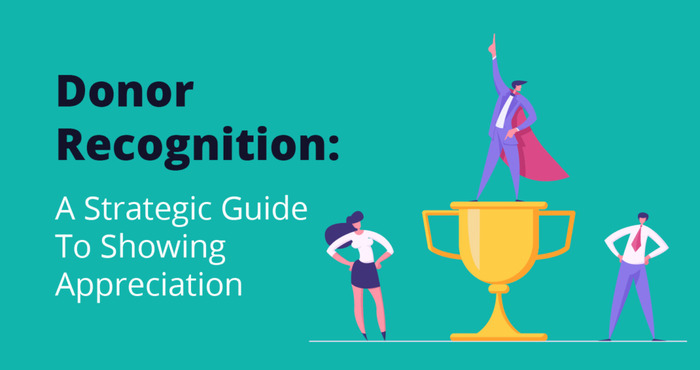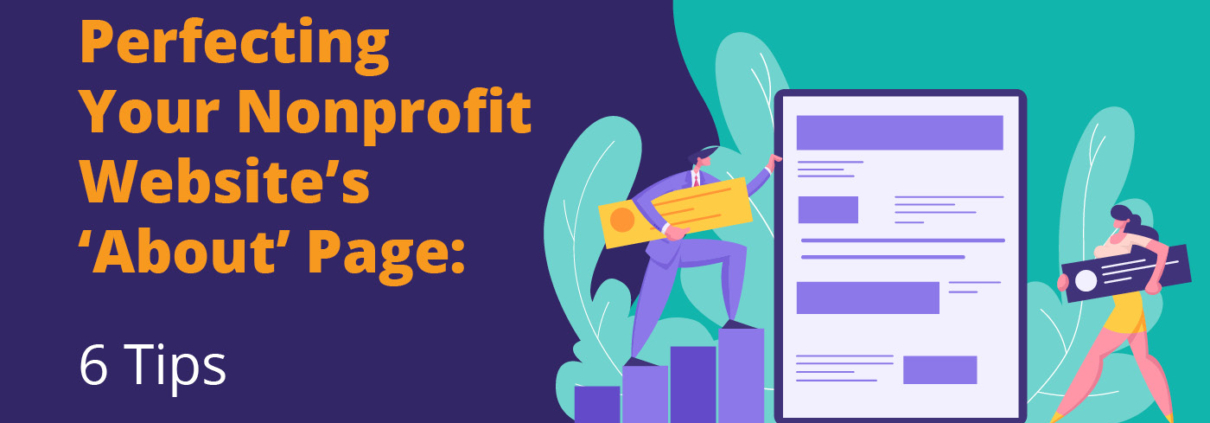Donor Recognition: A Strategic Guide To Showing Appreciation
Put yourself in a donor’s shoes. After perusing a nonprofit’s website, you take the plunge and make a sizeable donation of $100. You receive an email with your tax receipt but don’t hear another word.
You were so inspired by their mission, but you didn’t receive so much as a thank-you email in return for your financial support. In turn, you feel slightly unappreciated and decide to look into other organizations pursuing similar causes. That’s why donor recognition is vital!
If that organization had reached out with a personalized thank-you letter, you’d be much more likely to give again. And while this example might sound a bit dramatic, it happens all the time. Nonprofits don’t always recognize those who give to their causes, and that can reflect poorly, especially when major contributions aren’t acknowledged.
If your nonprofit’s donor recognition strategies are lacking, you’ve come to the right place! To help, we’ll highlight the importance of thanking your donors and explore creative ways you can show your appreciation. Here’s what you can expect:
- What Is Donor Recognition?
- Reasons Why You Should Recognize Your Donors
- 14 Donor Recognition Ideas
- Donor Appreciation Best Practices
At NXUnite, we’ve worked with several of the industry’s leading professionals. These thought leaders regularly share their expertise on how nonprofits can thrive in an ever-changing landscape. One of the timeless strategies we’ve noticed is that acknowledging donors is a must for establishing a reliable base of support.
With a few creative donor recognition ideas in your back pocket, your donors will know just how much their contributions are valued. In no time, you’ll inspire them to stick around for the long haul.


What Is Donor Recognition?
Donor recognition is the process of thanking supporters for their contributions to your organization. While the term is typically associated with individual contributions, nonprofits can express appreciation for anyone that’s donated money, goods, or services to their cause. That includes businesses and other organizations.
Acknowledgment can occur either privately—such as by personal letter or phone call—or publicly—like with a donor wall or other display. Depending on your supporters’ preferences, acknowledging their contributions can take many forms, from a simple thank-you letter to more elaborate awards, plaques, or public displays of appreciation.
Organizations often separate donor recognition into tiers based on the type of gift and the total amount given. The higher the amount, the greater the level of recognition. For example, a major donor might receive a lasting thank-you on a donor wall, while a donor who gave $30 might receive a personalized eCard.

Reasons Why You Should Recognize Your Donors
Recognizing your donors is the number one way to nurture positive relationships with them. You want them to feel valued and speak positively about your organization. By taking the time to express your gratitude, you can positively impact your work in several ways. For example, you’ll be able to:
- Increase your donor retention rate. When donors feel appreciated, they’ll stick around for the long haul. Even small, recurring donations can add up. So, no matter the size of their gift, expressing gratitude can go a long way.
- Motivate existing donors to give more. Donors continue supporting charities when they feel like they’re making a difference. By recognizing their contributions and giving insight into their impact, you can make them feel like their support is essential to your success. In turn, they may donate more in the future.
- Acquire new donors. When you thank those who support your cause, others will take notice. Whether you do so publicly or privately, the word will get around to new prospects. Existing donors will brag about your team. When others see that your nonprofit clearly appreciates its donors, they’ll want to give too.
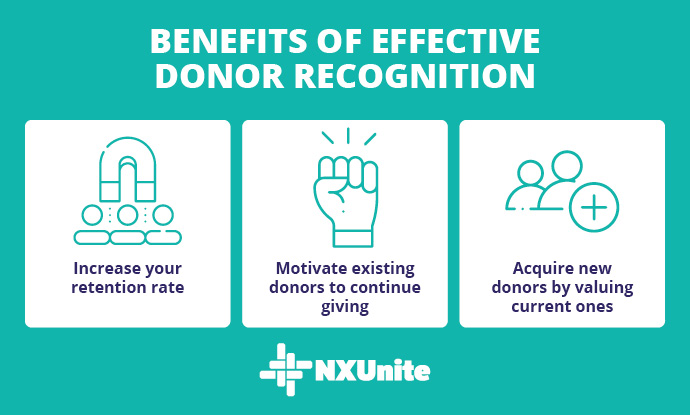
Properly thanking supporters for their committed support can transform your nonprofit’s abilities. After all, your donors are the lifeblood of your organization, so you want to take steps to attract and retain them every chance you get.

14 Donor Recognition Ideas
Creative recognition ideas will empower you to connect with donors and retain their support. While a simple “thank you” can go a long way, you’ll want to get creative to make a lasting impression on donors.
If your current strategies aren’t making the cut, we’ve curated a list of our top donor recognition ideas we think you’ll love.

Personalized eCards
What is the best gift for donor recognition? A personalized thank-you eCard, of course!
Take the traditional thank-you email up a notch and offer a visually-engaging token of appreciation. eCardWidget’s guide to charity eCards explains that eCards work for several reasons. For example, they offer benefits like:
- Convenience and affordability. Forgo mail processing time and postage costs. Within seconds, you can submit a personalized thank-you card, and it’ll appear in your donor’s inbox. By skipping snail mail, you’ll provide instant gratification.
- Interactiveness. You can include interactive elements that simulate the feeling of opening a physical greeting card. For example, recipients can click an image of an envelope to reveal the card.
- Customization. Digital cards are extremely customizable, making it easy to match them to your nonprofit’s mission. You can even include videos and other animations, unlike traditional greeting cards.
Create personalized thank-you eCards that reflect your nonprofit’s unique voice and brand. Then, send them to your generous donors. They’re an incredibly cost-effective and personalized way to express appreciation. Your donors will love receiving online greeting cards that communicate your appreciation for them, like this example from Youth For Understanding:
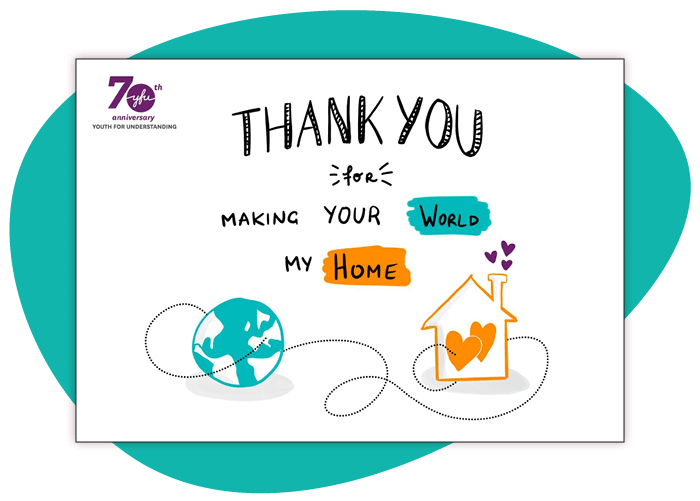
Send charity eCards post-donation or during key times of the year, like on recipients’ birthdays or during the holiday season. This is a great way to let donors know you’re thinking about them. By sending a personalized eCard, you’ll create a lasting memory for givers.


Thank You Letters
Personalized notes that show gratitude for a donor’s support are a classic way to express appreciation. A well-crafted email or a handwritten letter that expresses genuine appreciation for the donor’s support is a simple and effective way to say “thank you.”
Your letter doesn’t have to be long. It can be as simple as crafting a couple of paragraphs, customized to speak to their specific relationship with your organization.
To personalize your letter, include information such as:
- The donor’s name
- The specific amount they donated
- Other engagement history, such as volunteering
- Information about their employer’s matching gift program, if they have one
Overall, a heartfelt note of gratitude can make a donor feel appreciated and valued for their contributions. In turn, this can help cultivate a lasting relationship, and recipients will recognize the effort that went into crafting a personalized letter.

Donor Recognition Walls
Creating a wall or display with the names of your donors is a visual way to acknowledge contributions. It allows you to take donor appreciation public by recognizing donors for their generous contributions in a place where all the world can see.
Donor walls can come in many forms, such as physical plaques or virtual displays. While traditionally built in the physical world, nonprofits with limited budgets can create virtual donor walls on their websites. Not only is this more budget-friendly, but you can update the wall in real time.
Either way, donor walls can feature donor names, photos, or messages of appreciation. You can also add special touches such as a donor of the month or yearly donor awards.
Whatever you decide, a donor wall is a great way to show your donors that their support is valued and appreciated. It’s also a great way to inspire others to give.

Donor Appreciation Events
If you want to go all out, host a donor appreciation event. Hosting an event specifically for your donors can make them feel special and can help your team show your gratitude for their support.
Plan exclusive events for your major donors. These events could be a private dinner, a VIP tour of your facility, or a special performance.
Virtual gatherings work well too, especially when supporters are scattered in different locations. Try hosting a casual virtual get-together or happy hour where everyone can come together on Zoom.

Social Media Recognition
While great for promoting your work, social media is also a great place for donor recognition. From Facebook to Instagram, recognize your donors on social media by:
- Tagging them in posts and stories about events they attend.
- Sharing personal impact stories from donors.
- Posting photos about projects their donations have made possible.
- Sharing videos and written testimonials from your beneficiaries.
Social media enables you to reach a wide audience, allowing you to showcase how much you love your donors. When you craft meaningful messages, your donors will feel compelled to share them with their networks. In turn, you can connect with new prospects, too.
Public donor recognition can be powerful. As our volunteer appreciation guide suggests, just make sure your supporters are fine with you publishing their pictures and names online first.

Donor Recognition Phone Calls
A personal phone call from a staff member or volunteer can make a donor feel valued and appreciated. You can have a personal conversation with your donor, showing them that you’re genuinely grateful for their support.
When speaking to your donors, use the opportunity to provide updates on your organization’s progress. Depending on time constraints, you might also use this as an opportunity to solicit feedback or other ideas for improving your work.
While an excellent way to express appreciation, this donor recognition idea can be time-consuming. Try to limit phone calls to individuals who give a certain amount and prefer this form of recognition.

Thank-You Videos
A personalized video message from your nonprofit’s staff is a creative and heartfelt way to show donor appreciation.
For major donations or big projects, interview a beneficiary to show just how much your donors’ gifts impact your mission. Sharing stories about how donor contributions have made a difference in the lives of those you serve is a powerful way to show gratitude and inspire continued support.
Tectonic Video’s nonprofit video storytelling guide explains that you should incorporate a few key elements, such as:
- A narrative arc that engages the audience
- Relatable characters
- Clear and consistent narration
- Compelling visuals
In turn, you’ll appeal to your donors’ emotions and leave a lasting impact on them.
When published online, well-produced videos can increase visibility for your cause, too! Others can see just how impactful donations are, prompting them to donate as well.

Branded Merchandise
Sending donors some merchandise connected to your mission can be an excellent token of appreciation.
Not to mention, it’s a fantastic way to tap into social proof. For example, let’s say you send some apparel to a committed donor. They might sport a trendy hat or t-shirt around town. This can prompt meaningful conversations about your mission. Even if people don’t ask them about it, others will see your organization’s name on it, prompting them to search for it online.
When it comes to merchandise, consider creating and sending the following as a way to recognize donors:
- Apparel like nonprofit t-shirts and hats
- Tote bags
- Mugs and water bottles
- Stickers and decals
- Keychains
Every time they put on their t-shirt or see your keychain when they unlock their front door, they’ll think of your nonprofit. Plus, they can wear or use these items proudly and spread the word about your nonprofit like we mentioned.

Exclusive Content
Providing exclusive content to your donors can make them feel like insiders. For example, if they designated their donation to a certain program, be sure to give them exclusive updates on the program’s progress.
As you brainstorm ideas for what content you’ll offer, consider these common donor recognition rewards:
- Digital content such as eBooks, videos, podcasts, and webinars
- Behind-the-scenes updates or sneak peeks
- Special reports
- Access to exclusive merchandise
Not only does offering exclusive content serve as a form of donor recognition, but it also provides an incentive for donors to continue giving. When you spend time creating valuable rewards, they’ll want to continue accessing the exclusive content.

Discounts at Local Businesses
Partner with local businesses like restaurants and stores to offer discounts to donors. Not only is this a great way to express appreciation, but it also allows you to tap into corporate social responsibility and promote local businesses.
Once you have discounts lined up, mail or email the coupon to your donors along with a note of your appreciation. You can say something simple like:
“Please enjoy 15% off your next purchase at [store] as a token of our appreciation for your continued support.”

Discounts For Your Events
Your nonprofit likely hosts events regularly. From family-friendly 5Ks to lavish galas, events are a powerful way to bring people together in support of your cause. Chances are, entry into these events isn’t free.
As a way to recognize your donors, offer discounts to your nonprofit’s events and conferences. To limit the number of people who receive discounted access, only promise these discounts to those who donate to specific campaigns or above certain amounts.

Handmade Donor Recognition Gifts
Creating handmade gifts, such as paintings, pottery, or crafts, is a creative way to show gratitude and acknowledge the donor’s support. The recipient will know you took the time to create something special just for them.
It can be as simple as a thank you card or as elaborate as a hand-painted portrait. The goal is to show them that their support is valued in a unique and personal way.
Maybe your organization aspires to provide vital resources to at-risk youth. You might have them craft something for mid-tier and major donors, making this donor recognition idea much more meaningful.

Donor Newsletter
Chances are, your nonprofit already sends a regular newsletter to its entire email subscription list. You use it as a way to communicate big updates, highlight upcoming events, and share volunteer opportunities. Intertwine this communication technique with your donor recognition strategy by sending an exclusive donor newsletter.
Send a personalized newsletter to your donors with updates on your nonprofit’s work, impact, and future plans. Include photos and stories to make it engaging and meaningful.
Alternatively, create a section in your regular newsletter that spotlights a different major donor each time. This is an excellent way to publicly recognize major gifts throughout the year.

Annual Gratitude Report
Your annual report provides a look back on your nonprofit’s year. It’s one of the most important documents you create all year. One easy way to thank your donors is by listing them in this highly-distributed document.
You have a couple of options with this donor recognition idea:
- List donors alphabetically
- Group donors based on donation ranges
If you want to kick things up a notch, consider creating a separate “gratitude report” exclusively for showcasing donors’ impact. While annual reports generally focus on hard stats from the past year, a gratitude report looks specifically at the wins for the year, communicates appreciation, and lays the groundwork for the upcoming year.
A few different organizations leverage this donor recognition strategy as a way to highlight those who make their work possible. Take the Pride Foundation’s Gratitude Report for example.
As a way to express donor appreciation, they crafted a virtual report that speaks directly to donors. In it, you’ll find highlights of the grants and scholarships the foundation was able to award alongside testimonials from those influenced by donations. This approach is a fantastic way to communicate your donors’ impact.

Donor Appreciation Best Practices
Beyond picking the right ideas, there’s an art to expressing your appreciation for donors. No matter your cause, make sure you craft a donor recognition strategy that adheres to these tried-and-true best practices:
- Do get creative with your donor recognition ideas. Anyone can send a generic thank-you email. Get creative with your ideas to stand out. Being creative can be as simple as creating custom eCards connected to your cause.
- Don’t wait to say thank you. The quicker you express appreciation, the better! If you wait too long, donors may think you’ve forgotten about them.
- Do develop a donor recognition plan. Developing a plan will help you define levels of donor recognition, the types of recognition your team will give, and who should be recognized.
- Don’t ignore donors’ recognition preferences. Saying “thank you” should be as personalized as possible. That means adhering to individuals’ preferences. If they prefer a private phone call, ring them up. If they want a public shoutout, draft a social media post!
- Do use donor-centric messaging. Focus on the donor and how their contribution will make a difference. Making your donor the center of the call allows you to emphasize gratitude and show that the organization values their contributions.
- Don’t overlook small donations. Acknowledge every donation you receive, no matter how big or small. Each contribution matters, so make sure you recognize each and every one of your donors.
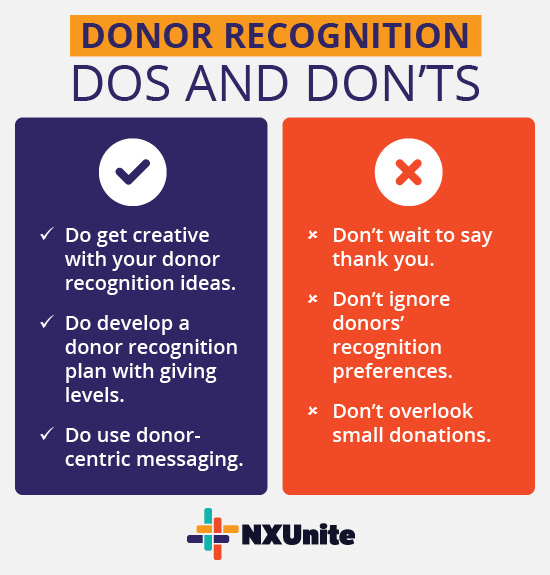
Sticking to these tips will enable you to recognize donors in meaningful ways that inspire them to stick around. Pay attention to how your donors respond and adjust accordingly.

Final Thoughts on Donor Recognition
If your nonprofit wants to build a reliable base of support, donor recognition isn’t an option! Thoughtful donor recognition helps build loyalty and encourages repeat giving from the same individuals. Public recognition can be especially impactful since others will see how much you value your supporters.
Ultimately, donor recognition is a powerful tool for any organization that wants to ensure the success of its fundraising efforts.
The donor recognition ideas we shared should give you everything you need to get started, but don’t stop there! To continue learning, check out some of these additional resources:
- The Ultimate Guide to Donor Retention: 8 Strategies. Acknowledging donors allows you to retain support. Learn more about why retention is vital and how you can calculate your retention rate.
- Digital Card Ideas To Engage Your Nonprofit’s Supporters. Online greeting cards are great for more than donor recognition. Explore different eCard designs that you can send or sell to supporters.
- How to Start a Fundraiser: The Nonprofit’s Ultimate Guide. Donor recognition is an important step for any fundraiser. But what about the steps that come before that? Explore everything you need to know about launching a fundraising campaign.
